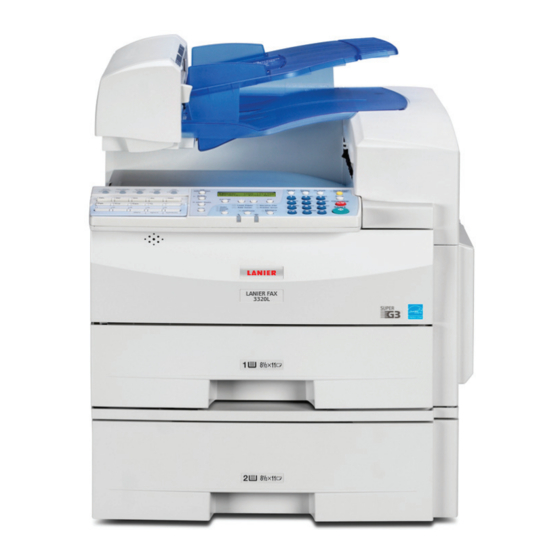
Summarization of Contents
1. Getting Started
Guide to Components
Identifies and describes the various parts and features of the machine's exterior.
Front View
Details components located on the front panel and exterior of the machine.
Side View
Identifies components and ports visible from the side of the machine.
Control Panel
Explains the function of each key, indicator, and the LCD display on the control panel.
Starting the Machine
Provides instructions on how to turn the machine on and off safely.
Turning On the Power
Step-by-step guide to powering up the machine.
Turning Off the Power
Instructions for correctly shutting down the machine.
Reading the Display
Explains how to interpret the machine's display and use the control keys.
Reading the Display and Using Keys
Details how to understand information shown on the LCD and operate the machine's keys.
Standby Display
Describes the information shown when the machine is in standby mode.
Communication Display
Explains the display information during fax transmission or reception.
Display Prompts
Covers various prompts and messages displayed by the machine during operation.
2. Faxing
Transmission Modes
Explains the two main modes for sending faxes: Memory and Immediate Transmission.
Switching between Memory Transmission and Immediate Transmission
Guides on how to select the desired fax transmission mode.
Setting Originals
Provides instructions on how to load various paper sizes into the document feeder.
Loading Originals in the Document Feeder
Detailed steps for placing originals into the automatic document feeder.
Original Sizes Difficult to Detect
Lists original types that the machine may have difficulty detecting.
Memory Transmission
Details the benefits and process of sending faxes from memory.
Canceling a Memory Transmission
Explains procedures for canceling a fax transmission stored in memory.
Before the Start Key is Pressed
How to cancel a memory transmission before it begins.
While the Original is Being Scanned
Procedure to stop transmission during the scanning phase.
During Transmission
How to cancel a fax transmission after the original has been scanned.
Canceling an Immediate Transmission
Provides steps to cancel immediate fax transmissions.
Before the Start key is Pressed
How to cancel an immediate transmission before initiating it.
After the Start key is Pressed
Procedure to cancel an immediate transmission after it has started.
Immediate Transmission
Explains the process and benefits of sending faxes immediately.
Scan Settings
Details options for adjusting scan settings to optimize image quality.
Resolution
Explains different resolution settings for faxing and their impact on quality and speed.
Original Type
Describes how to select original type settings for optimal fax clarity.
Dialing
Outlines the various methods for dialing fax numbers.
Entering Numbers Directly
How to manually enter fax numbers using the keypad.
Using Quick Dials
Instructions for dialing using pre-programmed Quick Dial keys.
Using Speed Dials
Guide to dialing using Speed Dial codes.
Using Groups
Explains how to send faxes to multiple destinations grouped together.
Pause
How to insert pauses when dialing or storing numbers.
Tone
Instructions for using tone signals for dialing.
Reception Modes
Describes the different modes for receiving faxes and calls.
Selecting the Reception Mode
Step-by-step guide to choosing the appropriate reception mode.
3. Registering
Own Name/Fax Header/Own Fax Number
Details how to register personal and machine identification information.
Quick Dial
Covers the process of programming and managing Quick Dial entries.
Registering
Steps to save destination fax numbers and names to Quick Dial keys.
Editing
Instructions on how to modify existing Quick Dial entries.
Deleting
Procedure for removing unwanted Quick Dial entries.
Quick Dial Key Label (Dial label)
How to print labels for Quick Dial keys.
Speed Dial
Explains how to register and manage Speed Dial entries.
Registering
Steps to program destination fax numbers and names into Speed Dials.
Editing
Instructions for modifying existing Speed Dial entries.
Deleting
Procedure for removing unwanted Speed Dial entries.
Groups
Covers managing groups of destinations for efficient broadcasting.
Registering groups in Quick Dial keys
How to register a group using Quick Dial keys.
Assigning the Group Functions to the Group key
Steps to assign group functionality to user function keys.
Registering
Detailed procedure for creating and registering new groups.
Editing a Group Name
Instructions for changing the name of an existing group.
Adding a Fax Number to a Group
How to add new destinations to an existing group.
To delete a destination from a group
Procedure for removing a specific destination from a group.
To delete an entire group
How to remove a group and all its destinations.
Entering Characters
Explains the process of entering text and numbers on the machine.
Available Characters
Lists all characters, numbers, and symbols usable for input.
Keys
Identifies keys used for character input and their functions.
Wild Cards
Details the use of wild cards for destination identification.
4. Troubleshooting
Clearing Original Jams
Step-by-step guide to removing jammed originals from the document feeder.
Clearing a Copy, Fax, or Print Jam
Instructions for clearing paper jams within the machine's internal path.
Loading Paper in the Main Paper Tray
Procedure for correctly loading paper into the main tray.
Adjusting Volume
How to change the volume levels for various machine sounds.
When the Receive File Indicator is Lit
Troubleshooting steps when the machine receives but cannot print a fax.
Solving Problems
Provides solutions for common operational issues and error messages.
Error Messages
Lists potential error messages and their corresponding solutions.
















Need help?
Do you have a question about the LF312 and is the answer not in the manual?
Questions and answers